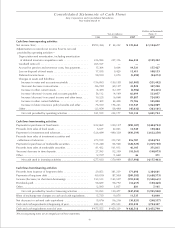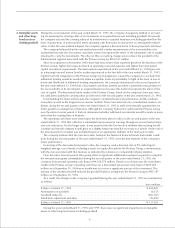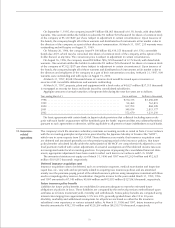Sony 1997 Annual Report Download - page 49
Download and view the complete annual report
Please find page 49 of the 1997 Sony annual report below. You can navigate through the pages in the report by either clicking on the pages listed below, or by using the keyword search tool below to find specific information within the annual report.
47
During the second quarter of the year ended March 31, 1995, the company changed its method of account-
ing for assessing the carrying value of its investments in acquired businesses including goodwill. Previously,
the company assessed the carrying value of its investments in acquired businesses including goodwill on the
basis of projections of undiscounted future operating cash flows plus an amount for an anticipated residual
value. Under the new method adopted, the company applied a discount factor to those projected cash flows.
The company believed that the new method provided a better measurement of the recoverability of its
investments because the discounted cash flows method recognized the effect of the substantial cost of capital
employed to carry the investments. The effect of this accounting change was to reduce the goodwill of the
Entertainment segment associated with the Pictures Group by ¥265,167 million.
Since its acquisition in November 1989, there had been slower than expected growth of the business of the
Pictures Group, higher than expected levels of operating costs and expenses and higher than anticipated
capital investment requirements. The deterioration experienced in the year ended March 31, 1994 gave rise
to a thorough internal review. Similar results experienced in the first half of the year ended March 31, 1995,
together with the resignation of the Pictures Group top management, caused the company to conclude that
additional funding would be needed to attain acceptable levels of profitability. In light of the level of invest-
ments and likelihood of additional funding requirements, the company determined in the second quarter of
the year ended March 31, 1995 that a discounted cash flows method provided a preferable measurement of
the recoverability of its investments in acquired businesses because this method recognizes the effect of the
cost of capital. The discounted future results of the Pictures Group, based on the company’s forecasts, were
not sufficient to justify the carrying value as of the end of the second quarter of the year ended March 31, 1995.
In formulating the financial forecasts, the company considered historical performance and the medium-
term plans as well as the longer-term economic outlook. These forecasts took into consideration market con-
ditions during the second quarter of the year ended March 31, 1995 as well as foreseeable opportunities for
future growth in existing lines of business. Although the company believed it could fund the Pictures Group
over the entire forecast period, it had not determined whether additional investments would be made in areas
other than the existing lines of business.
The operating cash flows were based upon the short-term plans in effect in the second quarter of the year
ended March 31, 1995 that called for a substantial improvement in earnings through recovered market share
and cost reductions. For the longer term, it was assumed that the low levels of inflation then existing would
continue and that the industry would grow at a slightly better rate than the economy as a whole. At the end of
the forecast period a residual was included based on an appropriate multiple of the final year’s results.
The company believes that the forecast results, based on the historical financial trends and market condi-
tions during the second quarter of the year ended March 31, 1995, were the best estimate of the company’s
future performance.
In arriving at the discounted net present value, the company used a discount rate of 9% reflecting its
weighted average cost of funds, including a factor for equity allocated to the Pictures Group, commensurate
with the risk associated with that business as indicated by reference to comparable industry statistics.
Over the entire forecast period, after giving effect to significant additional investment required to complete
the investment program contemplated during the second quarter of the year ended March 31, 1995, the
company forecast total operating cash flows of ¥4,166,374 million. Based on such forecasts, the cumulative
results of the Pictures Group’s operating cash flows on a discounted net present value basis of ¥309,005
million as of September 30, 1994 were insufficient to recover a significant portion of the investment. The
amount of the resultant shortfall reduced the goodwill balance arising from the Pictures Group to ¥85,197
million as of September 30, 1994.
As a result, the changes in the company’s goodwill during the year ended March 31, 1995 are summarized
as follows:
Yen in millions
Balance at March 31, 1994 . . . . . . . . . . . . . . . . . . . . . . . . . . . . . . . . . . . . . . . . . . . . . . ¥ 424,482
Amortization of goodwill . . . . . . . . . . . . . . . . . . . . . . . . . . . . . . . . . . . . . . . . . . . . . . . . (8,037)
Goodwill write-off . . . . . . . . . . . . . . . . . . . . . . . . . . . . . . . . . . . . . . . . . . . . . . . . . . . . . (265,167)
Translation adjustment and other . . . . . . . . . . . . . . . . . . . . . . . . . . . . . . . . . . . . . . . . . . (29,895)
Balance at March 31, 1995 . . . . . . . . . . . . . . . . . . . . . . . . . . . . . . . . . . . . . . . . . . . . . . ¥ 121,383
During the years ended March 31, 1996 and 1997, there were no significant impairments of intangible
assets or other long-lived assets including goodwill.
4. Intangible assets
and other long-
lived assets in-
cluding goodwill
























